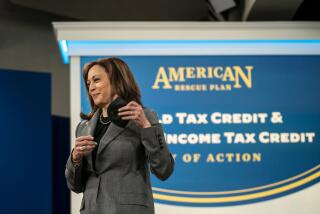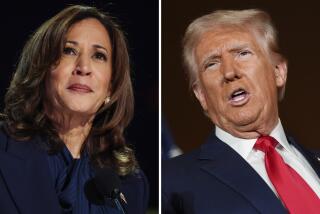NEWS ANALYSIS : Competing Tax Plans Seen Offering Dubious Benefits
WASHINGTON — President Bush and Democratic congressional leaders are wheeling out their big guns for a major political confrontation on the House floor this week over whether to cut the capital gains tax rate or expand tax breaks for individual retirement accounts.
But when the two sides argue the economic consequences of their proposals, they are mostly shooting blanks.
Contrary to Republican claims, there is little evidence from impartial economic research that a lower capital gains tax rate would do much to spur innovation, stimulate the economy or significantly boost government revenues in the long run.
At the same time, the Democratic counterproposal--to pay for more IRA tax breaks with a higher tax rate on upper-income taxpayers--probably offers equally dubious benefits for savings and investment. Although there is no consensus, many economists argue that most money socked away in tax-sheltered IRAs would have been saved even without the tax break.
“This is not an economic debate,” said Barry Bosworth, a leading economic analyst at the Brookings Institution. “This is a political showdown. The problem is that both sides grossly exaggerate the benefits from the tax changes they advocate.”
The political rhetoric escalated Monday, with White House Budget Director Richard G. Darman accusing congressional Democratic leaders of following a “kamikaze approach to national politics” aimed at creating budgetary chaos designed to force a tax hike. House Speaker Thomas S. Foley (D-Wash.) dismissed Darman’s attack as “nonsense” and “unworthy of him.”
The economic arguments, while not so shrill, carry more potential significance for the country. Nearly all economists agree that additional savings--the stated goals of both the Republican and the Democratic tax proposals--would help the economy by making more money available at lower cost for the investment that helps ensure rising prosperity in the future.
But the measures Congress is considering show little promise of moving the nation any closer toward those goals.
“The problem with all these claims about the benefits of tax incentives is that other things going on in the economy are so much more important,” said Edward Yardeni, chief economist at Prudential-Bache Securities in New York. “Any tax changes are almost insignificant by comparison.”
For more than a decade, the federal government has been experimenting with different ways to stimulate higher savings and investment. It has had little success.
Starting in 1978, Congress approved several reductions in the top capital gains tax rate--on profits from stocks, real estate and most other assets--to a low of about 20% by 1983. At the same time, lawmakers expanded tax breaks for individual retirement accounts, opening them to all working taxpayers in the major tax cut of 1981. The lower tax rates, combined with Congress’ decision to deregulate interest rates and the Federal Reserve’s tight-money policy, drove the after-tax return on savings to unprecedented levels in the 1980s.
Several economists, including Michael J. Boskin, chairman of the Council of Economic Advisers, had predicted that savings would rise significantly in response to the promise of higher returns. But it did not work out that way.
Instead, private savings by Americans, which had been remarkably stable at about 9% to 10% of the national economic output from the 1950s through the 1970s, plunged to a low of about 6% in 1987. Most economists concluded that savings do not respond significantly to higher returns and are much more sensitive to demographic trends and changes in wealth.
At the same time, the huge federal deficits of the 1980s--caused in part by sharply expanding tax breaks--aggravated the problem by absorbing U.S. savings that might otherwise have gone to private investment.
Another sign of the failure of incentives was that after Congress removed the special tax breaks for capital gains and IRAs in the sweeping 1986 tax revision law, both savings and investment began to rebound. And even if that seemingly paradoxical reaction was unrelated to the tax reforms, it is further evidence that such tax law changes carry little weight in the giant, complex U.S. economy.
Although there is a good case that the higher income tax rates of the 1970s hurt economic growth, advocates of cutting capital gains taxes today carry the argument much further.
Even though federal tax rates are much lower now than they were in the 1970s, supporters contend that capital gains taxes should be cut below ordinary income tax rates to reward entrepreneurs for starting new businesses. They say that the relatively high capital gains tax rate puts the United States at a disadvantage against its major trading partners.
“The issue is: Does lowering capital gains produce more productive investment?” Darman asked rhetorically during a briefing with reporters Monday. “Generally, the answer . . . is yes.”
Darman, his tongue only partly in cheek, added that “a vote against capital gains is a vote against farmers, small owners of timber stands, people who raise Christmas trees, a father who builds a little steak submarine sandwich business.”
To Darman’s critics, that points up the key problem with relying on a capital gains tax cut to stimulate the economy. To provide some modest benefits for new investment, a cut in the capital gains rate showers billions of dollars in extra tax savings on those who are simply cashing in past investments or reshuffling existing assets.
“For successful entrepreneurs, the returns are so high that small differences in the rate of taxation are simply irrelevant,” concluded Michael Barker, an economic analyst formerly with the moderate-to-conservative Democratic Leadership Council, after extensive research on the capital gains issue.
And Barker disputes the claim that other countries are better off because they avoid most capital gains taxes.
“Has the absence of a capital gains tax stimulated the emergence of a venture capital industry in Japan or West Germany?” he asks. “Has it made the young people of either country entrepreneurial? No way.”
Similar problems bedevil the claim that tax breaks for IRAs add significantly to the nation’s pool of savings.
Some studies, including a recent report sponsored by Merrill Lynch, claim that as much as 80% of the money put into IRAs during the 1980s represented extra savings rather than money that was simply transferred from another source.
But Brookings’ Bosworth, who has closely studied the savings debate, calls the Merrill Lynch conclusions “a joke. They made no attempt to control for substitution effects.”
Other research, by Harvard economist David Wise and Stephen Venti of Dartmouth, found that IRAs may have produced a net gain of 20 to 25 cents in extra savings for every $1 added to an IRA. But Bosworth says that the much more modest claim of Wise and Venti may also be questionable because no research actually tracked the behavior of savers over a multi-year period.
More to Read
Get the L.A. Times Politics newsletter
Deeply reported insights into legislation, politics and policy from Sacramento, Washington and beyond. In your inbox three times per week.
You may occasionally receive promotional content from the Los Angeles Times.










